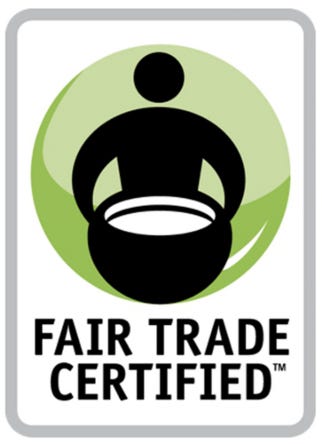March 11, 2015

Fair Trade Certified logo 2012
Fair Trade USA, the leading third-party certifier of Fair Trade products in the United States, has unveiled a redesigned certification label and significant revisions to its Multiple Ingredients Product Policy. The changes will better serve the needs of farmers, businesses and consumers that look to the Fair Trade Certified label to ensure that rigorous standards, transparency and efforts to provide the greatest impact possible have been met.
Under the revised Ingredients Policy, which applies to all food and personal care products, only products that contain 100 percent Fair Trade Certified ingredients may bear the full Fair Trade Certified label. Products containing at least 20 percent Fair Trade Certified ingredients will now bear a new Fair Trade Certified Ingredients label.
The Fair Trade Certified label, now found on more than 10,000 products throughout the United States, ensures shoppers that the farmers and workers producing the labeled goods were paid fair prices and wages, work in safe conditions, protect the environment, and earn community development funds to empower and improve their communities.
Redesigned certification label
The updated label, a significant deviation from the original black-and-white Fair Trade Certified label, can be used in any country in the world. It was also designed to visually highlight the important benefits of Fair Trade.
"The clearer, more modern design helps the label 'pop' better on the shelf, enabling consumers to quickly find Fair Trade Certified products where they shop, while better communicating the importance of Fair Trade certification," said Ivan Blackshear, Graphic Design Manager at Fair Trade USA. "The use of green expresses the environmental benefits inherent in Fair Trade, and the simpler, 'farmer with an open basket' design communicates the reciprocal relationship we have with the farmers that produce our food."
It is the first time that Fair Trade USA has refreshed its logo since the organization's inception in 1998. Brands are encouraged to convert to the updated logo on packaging by October 2012, but Fair Trade USA will continue to support both the old and new labels to minimize marketplace confusion.
This globally-registered mark, already beginning to appear on store shelves across the nation, offers a simple labeling solution to companies working with Fair Trade USA in multiple countries. The two versions of the label, Fair Trade Certified and Fair Trade Certified Ingredients, clearly highlight the difference between products with varying percentages of Fair Trade Certified ingredients.
Multiple Ingredients Product Policy changes
Developed in response to a comprehensive two-month consultation period with multiple stakeholders in the Fair Trade movement, the new draft of Fair Trade USA's Multiple Ingredients Product Policy clearly defines the composition and labeling requirements for products that contain a mixture of both Fair Trade Certified ingredients and ingredients for which Fair Trade standards do not currently exist, like eggs, wheat and dairy.
"The revised Ingredients Policy reflects our organization's commitment to include more farmers and workers in the Fair Trade model, and our desire to raise the bar for certification transparency," says Paul Rice, president and CEO of Fair Trade USA. "It's designed to offer more Fair Trade farmers the opportunity to sell their products into the global market, enable more companies to make a meaningful impact through responsible sourcing, and accurately communicate to shoppers the social and environmental benefits of purchasing Fair Trade Certified products."
Under the revised policy, only products with 100 percent Fair Trade Certified content can use the full label. To use the ingredients label:
1.100 percent of the ingredient commonly associated with a product must be Fair Trade Certified. For example, a chocolate bar must contain 100 percent Fair Trade Certified cocoa.
2.For any individual Fair Trade Certified ingredient used in the product, 100 percent of that ingredient must be certified. For example, if a product contains Fair Trade Certified vanilla extract, all of the vanilla extract in the product must be Fair Trade Certified.
3.The product must contain at least 20 percent Fair Trade Certified content in total, and all ingredients that can be Fair Trade Certified must be Fair Trade Certified, if the ingredient is commercially available.
In the case of single-ingredient products, like tea and coffee, Fair Trade USA will continue to require that 100 percent of the product be Fair Trade Certified. The policy also requires full web disclosure of all ingredients contained in a product.
"The changes to our Ingredients Policy reinforce the integrity and rigor of the Fair Trade Certified label while maximizing impact for farmers and workers by enabling their products to be included in a wider array of consumer goods," says Cate Baril, director of business development, CPG at Fair Trade USA. "Our new policy provides a point of entry for both farmers and businesses, and encourages companies to include more Fair Trade Certified ingredients in their products."
Since 2009, sales of products containing Fair Trade Certified ingredients have resulted in more than $3.4 million in premiums to support the development of farming communities around the globe.
The full draft policy can be viewed at www.fairtradeusa.org/certification/producers/ingredients and is open for a 60 day public comment period.
Fair Trade USA, a nonprofit organization, is the leading third-party certifier of Fair Trade products in the United States. Fair Trade USA audits and certifies transactions between U.S. companies and their international suppliers to guarantee that the farmers and workers producing Fair Trade Certified goods were paid fair prices and wages, work in safe conditions, protect the environment, and receive community development funds to empower and improve their communities.
Source: Fair Trade USA
.
About the Author(s)
You May Also Like


